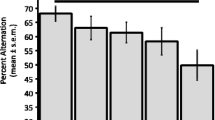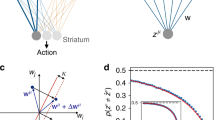Abstract
Twenty-eight subjects practised a task involving procedural knowledge in which a moving target has to be followed for two 3-min sessions. They were then randomly allocated to receive an IV injection of 0.4 mg scopolamine, 0.15 mg clonidine or saline. General impairment due to both active treatments was seen 20 min later in significantly decreased tracking performance. Subjects then had to learn a mirror-reversed version of the tracking task. This involved acquiring novel procedural knowledge. Subjects who had either saline or clonidine treatment showed rapid temporary improvements and also considerable permanent learning. Subjects treated with scopolamine, however, showed only slow temporary improvement and little permanent improvement in their performance at this task. This result suggests that a normally functioning cholinergic system is necessary not only for an efficient working memory but also for the long term acquisition of some kinds of procedural knowledge.
Similar content being viewed by others
References
Baddeley AD (1986) Working memory. Oxford University Press, London
Baddeley AD, Hitch GJ (1976) Working memory. In: Bower G (ed) Recent advances in learning and motivation, vol. III. Academic Press, New York
Caine ED, Weingartner H, Ludlow CL, Cudahy EA, Wehry S (1981) Quantitative analysis of scopolamine induced amnesia. Psychopharmacology 74:74–80
Charney DS, Heninger GR, Redmond DG (1983) Yohimbine induced anxiety and increased noradrenergic function in humans: Effects of diazepam and clonidine. Life Sci 33:19–29
Clark CR, Geffen GM, Geffen LB (1986) Role of monoamine pathways in attention and effort: effects of clonidine and methylphenidate in normal adult humans. Psychopharmacology 90:35–39
Crow TJ, Grove-White IG (1973) An analysis of the learning deficit following hyoscine administration to man. Br J Pharmacol 49:322–327
Eysenck HJ, Frith CD (1977) Reminiscence, motivation and personality. Plenum Press, New York
Frith CD, Lang R (1979) Learning and reminiscence as a function of target predictability in a two-dimensional tracking task. Q J Exp Psychol 31:103–109
Frith CD, Richardson JTE, Samuel M, Crow TJ, McKenna PJ (1984) The effects of intravenous diazepam and hyoscine upon human memory. Q J Exp Psychol 36A:133–144
Frith CD, Dowdy J, Ferrier IN, Crow TJ (1985) Selective impairment of paired associate learning after administration of a centrally-acting adrenergic agonist (clonidine). Psychopharmacology 87:490–493
Frith CD, Bloxham CA, Carpenter KN (1986) Impairments in the learning performance of a new manual skill in patients with Parkinson's disease. J Neurol Neurosurg Psychiatry 49:661–668
Lang R, Frith CD (1981) Learning and reminiscence in the pursuit rotor performance of normal and depressed subjects. Personality and Individual Differences 2:207–213
Mackay C, Cox T, Burrows G, Lazgenini T (1978) An inventory for the measurement of self-reported stress and arousal. Br J Soc Clin Psychol 17:283–284
Mewaldt SP, Ghonheim MM (1979) The effects and interactions of scopolamine, physiostigmine and methamphetamine in human memory. Pharmacol Biochem Behav 10:205–210
Nissen MJ, Knopman DS, Schacter DL (1987) Neurochemical dissociations of memory systems. Neurology 37:789–794
Parrott AC (1986) The effects of transdermal scopolamine and four dose levels of oral scopolamine (0.15, 0.3, 0.6, and 1.2 mg) upon psychological performance. Psychopharmacology 89:347–354
Rawlings EI, Rawlings IL, Chen SS, Yilk MD (1972) The facilitating effects of mental rehearsal in the acquisition of rotary pursuit tracking. Psychon Sci 26:71–73
Robbins TW, Everitt BJ (1982) Functional studies of the central catecholamines. Int Rev Neurobiol 23:303–365
Author information
Authors and Affiliations
Rights and permissions
About this article
Cite this article
Frith, C.D., McGinty, M.A., Gergel, I. et al. The effects of scopolamine and clonidine upon the performance and learning of a motor skill. Psychopharmacology 98, 120–125 (1989). https://doi.org/10.1007/BF00442017
Received:
Accepted:
Issue Date:
DOI: https://doi.org/10.1007/BF00442017




